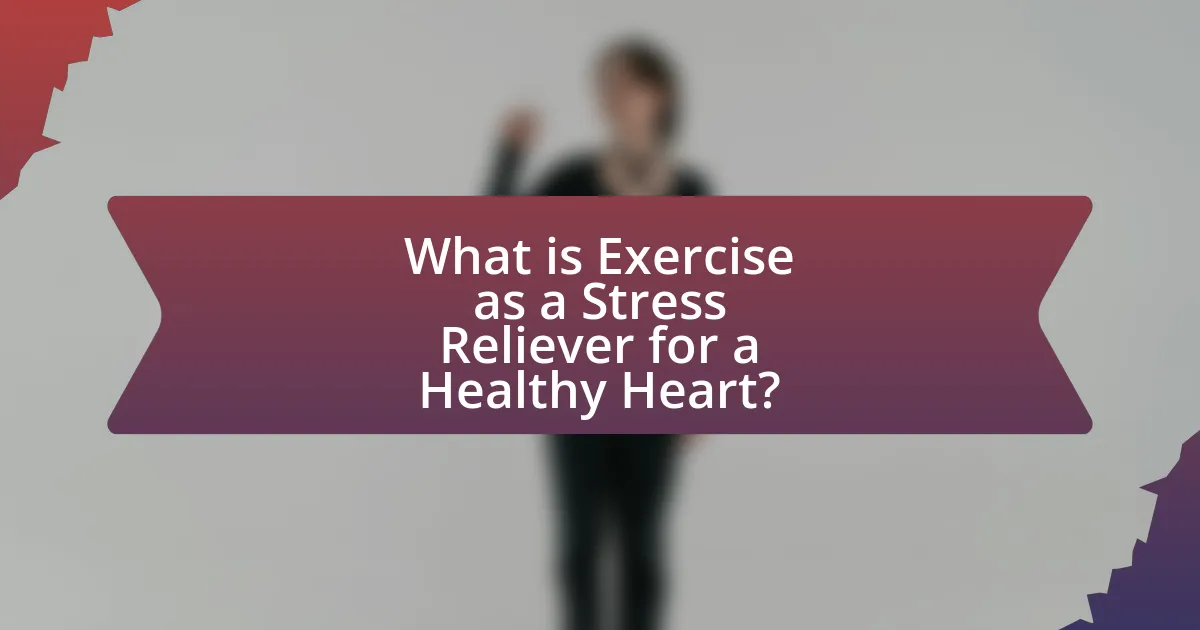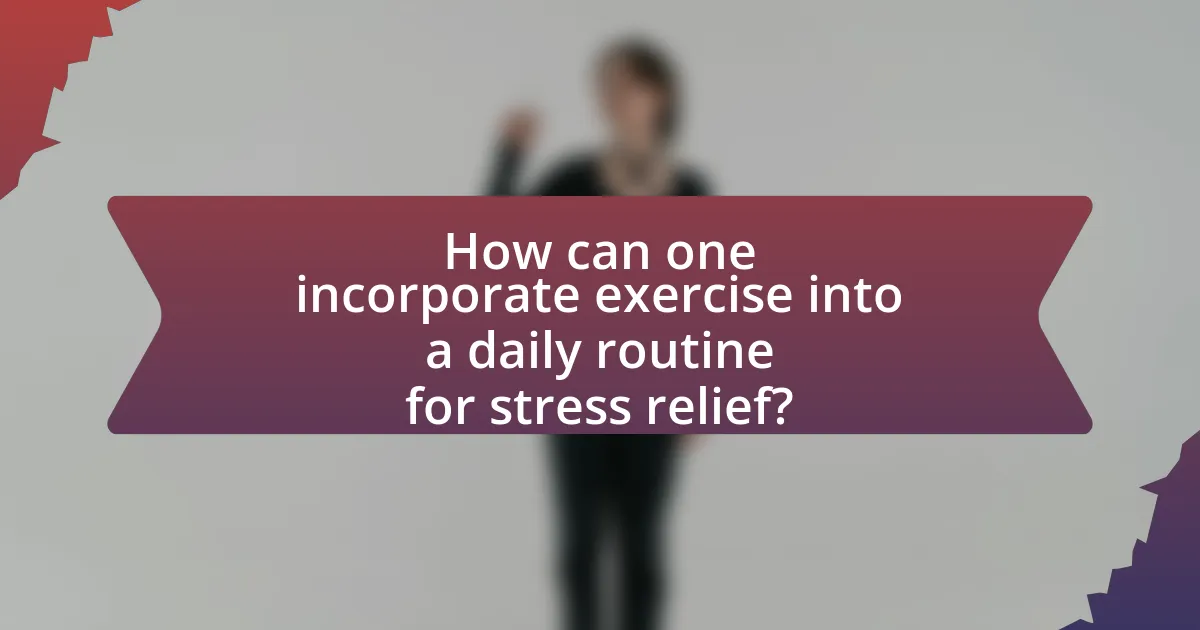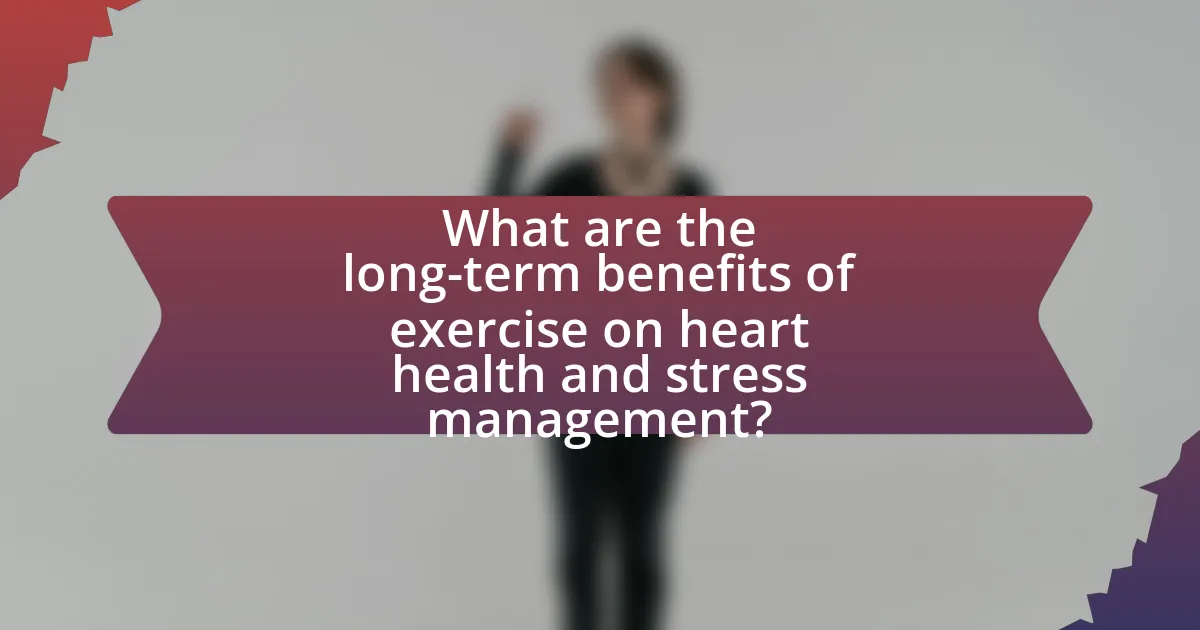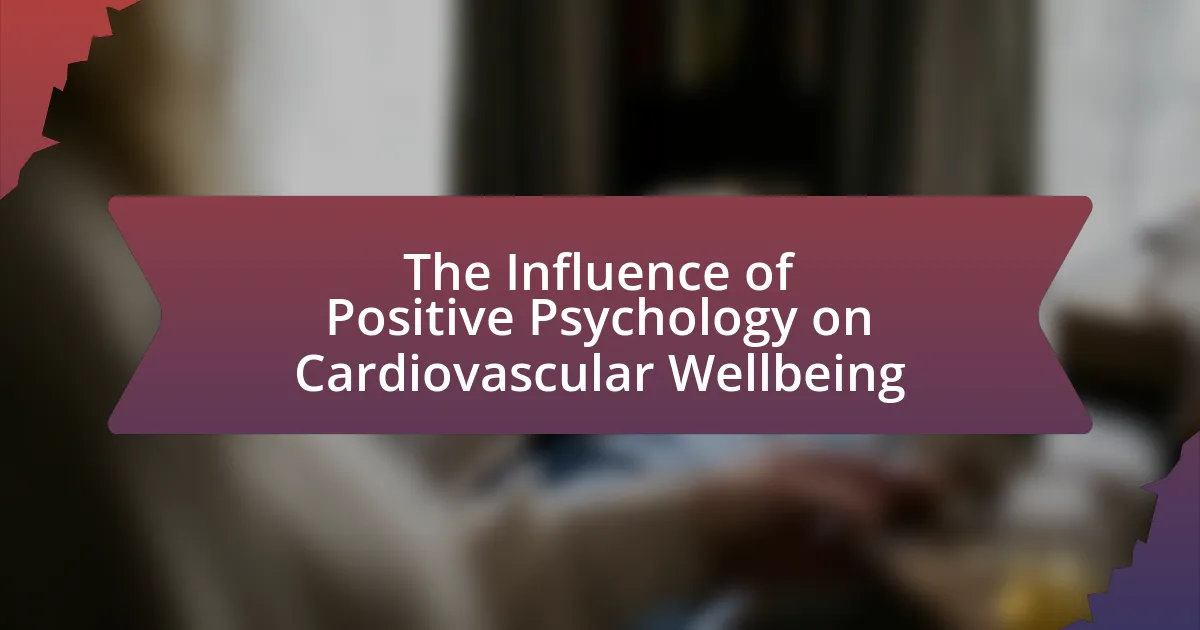Exercise is a vital stress reliever that contributes to a healthy heart by promoting the release of endorphins and reducing stress hormones like cortisol and adrenaline. Regular physical activity, particularly aerobic exercises, has been shown to lower anxiety and depression rates, thereby enhancing cardiovascular health. The article explores the physiological changes during exercise that alleviate stress, the impact of exercise on mental health, and the importance of heart health in relation to stress. It also discusses effective types of exercise for stress relief, strategies for incorporating exercise into daily routines, and the long-term benefits of regular physical activity on heart health and overall well-being.

What is Exercise as a Stress Reliever for a Healthy Heart?
Exercise serves as a stress reliever for a healthy heart by promoting the release of endorphins, which are chemicals in the brain that act as natural painkillers and mood elevators. Engaging in regular physical activity, such as aerobic exercises, has been shown to reduce levels of the body’s stress hormones, including adrenaline and cortisol. Research indicates that individuals who exercise regularly experience lower rates of anxiety and depression, contributing to improved cardiovascular health. For instance, a study published in the Journal of the American College of Cardiology found that moderate exercise can significantly lower the risk of heart disease by improving heart function and reducing stress levels.
How does exercise impact stress levels?
Exercise significantly reduces stress levels by promoting the release of endorphins, which are chemicals in the brain that act as natural painkillers and mood elevators. Engaging in physical activity also lowers the levels of stress hormones, such as cortisol, thereby enhancing overall emotional well-being. Research published in the Journal of Clinical Psychiatry indicates that regular exercise can decrease anxiety and depression symptoms, with a meta-analysis showing that individuals who engage in aerobic exercise experience a 20-30% reduction in stress levels. This evidence supports the conclusion that exercise serves as an effective mechanism for stress relief, contributing to a healthier heart and improved mental health.
What physiological changes occur during exercise that reduce stress?
During exercise, the body undergoes several physiological changes that significantly reduce stress. These changes include the release of endorphins, which are natural mood lifters, and the reduction of stress hormones such as cortisol and adrenaline. Research indicates that physical activity increases blood flow to the brain, enhancing cognitive function and promoting a sense of well-being. Additionally, exercise stimulates the production of neurotransmitters like serotonin and dopamine, which contribute to improved mood and reduced anxiety. Studies have shown that regular physical activity can lead to long-term reductions in stress levels, as evidenced by a meta-analysis published in the journal Health Psychology Review, which found that exercise interventions consistently lower perceived stress among participants.
How does regular exercise influence mental health?
Regular exercise significantly improves mental health by reducing symptoms of anxiety and depression. Engaging in physical activity stimulates the release of endorphins, which are neurotransmitters that promote feelings of happiness and well-being. Research published in the journal “JAMA Psychiatry” indicates that individuals who engage in regular exercise experience a 20-30% reduction in the risk of developing depression. Additionally, exercise enhances cognitive function and can lead to improved mood and reduced stress levels, as evidenced by a study from the University of Vermont, which found that participants who exercised reported lower levels of stress and anxiety.
Why is heart health important in relation to stress?
Heart health is crucial in relation to stress because chronic stress can lead to cardiovascular problems, including hypertension and heart disease. When an individual experiences stress, the body releases hormones like cortisol and adrenaline, which can increase heart rate and blood pressure. Over time, these physiological changes can damage blood vessels and contribute to the development of heart-related issues. Research indicates that individuals with high stress levels are at a greater risk for heart attacks and strokes, highlighting the importance of maintaining heart health to mitigate the adverse effects of stress.
What are the effects of stress on heart health?
Stress negatively impacts heart health by increasing the risk of cardiovascular diseases. Chronic stress leads to elevated levels of cortisol and adrenaline, which can raise blood pressure and heart rate. This physiological response can contribute to the development of atherosclerosis, where arteries become narrowed due to plaque buildup. Research indicates that individuals experiencing high stress levels are more likely to suffer from heart attacks and strokes. For instance, a study published in the Journal of the American College of Cardiology found that stress is a significant risk factor for coronary artery disease, highlighting the direct correlation between stress and heart health.
How can exercise mitigate these effects?
Exercise can mitigate the effects of stress on heart health by reducing levels of cortisol and adrenaline, which are hormones associated with stress. Engaging in regular physical activity promotes the release of endorphins, chemicals in the brain that act as natural painkillers and mood elevators. Studies show that individuals who participate in aerobic exercise, such as running or cycling, experience a significant decrease in stress levels and improved cardiovascular function. For instance, a study published in the Journal of Clinical Psychiatry found that moderate exercise can reduce anxiety and depression symptoms, leading to better heart health outcomes.
What types of exercise are most effective for stress relief?
Aerobic exercises, such as running, swimming, and cycling, are most effective for stress relief. These activities increase the production of endorphins, which are natural mood lifters. Research published in the Journal of Clinical Psychiatry indicates that regular aerobic exercise can significantly reduce symptoms of anxiety and depression, enhancing overall emotional well-being. Additionally, yoga and mindfulness-based exercises have been shown to lower cortisol levels, the hormone associated with stress, further supporting their effectiveness in stress relief.
Which aerobic exercises are beneficial for heart health?
Aerobic exercises that are beneficial for heart health include running, cycling, swimming, and brisk walking. These activities enhance cardiovascular fitness by increasing heart rate and improving blood circulation. Research indicates that regular participation in these exercises can lower the risk of heart disease, reduce blood pressure, and improve cholesterol levels. For instance, a study published in the Journal of the American College of Cardiology found that individuals engaging in moderate to vigorous aerobic exercise had a significantly lower risk of cardiovascular events compared to sedentary individuals.
How do strength training and flexibility exercises contribute to stress relief?
Strength training and flexibility exercises contribute to stress relief by promoting the release of endorphins, which are natural mood lifters. Engaging in strength training has been shown to reduce levels of cortisol, a hormone associated with stress, thereby enhancing overall emotional well-being. Additionally, flexibility exercises, such as yoga and stretching, help to alleviate muscle tension and promote relaxation, further reducing stress levels. Research published in the Journal of Clinical Psychology indicates that regular physical activity, including both strength training and flexibility exercises, can significantly lower anxiety and improve mood, supporting the effectiveness of these exercise types in stress management.

How can one incorporate exercise into a daily routine for stress relief?
Incorporating exercise into a daily routine for stress relief can be achieved by scheduling specific times for physical activity, such as morning walks or evening workouts. Regular exercise, even for just 30 minutes a day, has been shown to reduce stress levels by releasing endorphins, which are natural mood lifters. Research published in the Journal of Clinical Psychiatry indicates that aerobic exercise can significantly decrease anxiety and improve overall mental health. By integrating activities like yoga, jogging, or cycling into daily life, individuals can create a consistent routine that promotes both physical fitness and emotional well-being.
What are some practical tips for starting an exercise regimen?
To start an exercise regimen, set clear and achievable goals, such as exercising for 30 minutes a day, five days a week. Establishing specific targets helps maintain motivation and track progress. Additionally, choose activities that you enjoy, as this increases adherence; for example, walking, cycling, or swimming can be effective and enjoyable. Incorporating a mix of cardiovascular, strength, and flexibility exercises ensures a well-rounded fitness routine, which is essential for overall health.
Furthermore, gradually increase the intensity and duration of workouts to avoid injury and burnout. Research indicates that starting slowly and progressively increasing activity levels can lead to better long-term adherence (American Heart Association). Lastly, consider scheduling workouts like appointments to prioritize them in your daily routine, making it easier to stay consistent.
How can one set realistic fitness goals?
To set realistic fitness goals, one should assess their current fitness level, define specific and measurable objectives, and establish a timeline for achieving these goals. Assessing the current fitness level involves evaluating factors such as endurance, strength, flexibility, and body composition. For instance, a beginner might aim to walk 30 minutes a day, while an experienced individual might target running a 5K in under 30 minutes. Specificity and measurability ensure that goals can be tracked, such as aiming to lose 5 pounds in two months or increasing weight lifted by 10% in six weeks. Establishing a timeline provides a clear framework for progress, making it easier to stay motivated and adjust goals as needed. Research indicates that setting SMART (Specific, Measurable, Achievable, Relevant, Time-bound) goals significantly enhances the likelihood of success in fitness endeavors.
What role does consistency play in achieving stress relief through exercise?
Consistency is crucial in achieving stress relief through exercise because regular physical activity leads to sustained physiological and psychological benefits. Engaging in exercise consistently helps regulate cortisol levels, which are linked to stress, and promotes the release of endorphins, enhancing mood and reducing anxiety. Research indicates that individuals who maintain a regular exercise routine experience lower levels of perceived stress and improved emotional resilience. For instance, a study published in the Journal of Clinical Psychology found that participants who exercised consistently reported a 20% reduction in stress levels compared to those who exercised sporadically. Thus, the role of consistency in exercise is fundamental for effective stress management and overall mental well-being.
How can social support enhance the exercise experience?
Social support enhances the exercise experience by increasing motivation, accountability, and enjoyment. When individuals engage in physical activity with friends or family, they are more likely to adhere to their exercise routines due to the encouragement and shared goals. Research indicates that social support can lead to higher levels of physical activity; for instance, a study published in the Journal of Sport and Exercise Psychology found that individuals who exercised with others reported greater enjoyment and were more likely to continue their exercise habits over time. This social interaction not only fosters a sense of community but also reduces feelings of isolation, making the exercise experience more fulfilling and effective in relieving stress.
What are the benefits of exercising with others?
Exercising with others enhances motivation, accountability, and social interaction, which can lead to improved physical and mental health outcomes. Group workouts often create a supportive environment that encourages individuals to push their limits, resulting in higher exercise adherence rates. Research indicates that individuals who engage in group exercise report greater enjoyment and satisfaction, which can reduce stress levels and promote heart health. A study published in the Journal of Sport and Exercise Psychology found that social support during exercise significantly increases the likelihood of maintaining a regular fitness routine, thereby contributing to overall well-being.
How can group activities improve motivation and reduce stress?
Group activities can improve motivation and reduce stress by fostering social connections and creating a supportive environment. Engaging in group exercises, such as team sports or fitness classes, enhances accountability, as individuals are more likely to stay committed when working towards a common goal with others. Research indicates that social interaction during physical activity releases endorphins, which are natural mood lifters, thereby reducing stress levels. A study published in the Journal of Sport and Exercise Psychology found that participants in group exercise reported higher levels of enjoyment and motivation compared to those exercising alone. This combination of social support and increased enjoyment leads to improved mental well-being and a more positive outlook on physical activity.

What are the long-term benefits of exercise on heart health and stress management?
Regular exercise significantly improves heart health and aids in stress management over the long term. Engaging in physical activity strengthens the heart muscle, enhances blood circulation, and reduces the risk of cardiovascular diseases. According to the American Heart Association, individuals who exercise regularly can lower their risk of heart disease by up to 30-40%.
Additionally, exercise promotes the release of endorphins, which are natural mood lifters, thereby effectively reducing stress levels. A study published in the Journal of Clinical Psychiatry found that regular physical activity can decrease symptoms of anxiety and depression, contributing to better overall mental health. Thus, the long-term benefits of exercise encompass both improved cardiovascular health and enhanced stress resilience.
How does regular exercise contribute to overall cardiovascular health?
Regular exercise significantly enhances overall cardiovascular health by improving heart function and reducing risk factors for heart disease. Engaging in physical activity strengthens the heart muscle, enabling it to pump blood more efficiently, which lowers resting heart rate and blood pressure. Additionally, exercise helps regulate cholesterol levels by increasing high-density lipoprotein (HDL) cholesterol while decreasing low-density lipoprotein (LDL) cholesterol and triglycerides. According to the American Heart Association, regular aerobic exercise can reduce the risk of cardiovascular disease by up to 30-40%. Furthermore, exercise aids in weight management and reduces stress, both of which are critical for maintaining a healthy cardiovascular system.
What are the specific heart health metrics improved by exercise?
Exercise improves several specific heart health metrics, including resting heart rate, blood pressure, cholesterol levels, and overall cardiovascular endurance. Regular physical activity strengthens the heart muscle, leading to a lower resting heart rate, which indicates improved heart efficiency. Studies show that aerobic exercise can reduce systolic and diastolic blood pressure by an average of 5 to 10 mmHg. Additionally, exercise positively affects lipid profiles by increasing high-density lipoprotein (HDL) cholesterol and decreasing low-density lipoprotein (LDL) cholesterol. Enhanced cardiovascular endurance is evidenced by improved VO2 max, a measure of the maximum amount of oxygen the body can utilize during intense exercise, which correlates with better heart health outcomes.
How does exercise influence longevity and quality of life?
Exercise significantly enhances longevity and quality of life by reducing the risk of chronic diseases and improving mental health. Regular physical activity lowers the incidence of conditions such as heart disease, diabetes, and certain cancers, which are leading causes of mortality. For instance, a study published in the Journal of the American College of Cardiology found that individuals who engage in moderate to vigorous exercise for at least 150 minutes per week have a 30-40% lower risk of premature death compared to sedentary individuals. Additionally, exercise promotes mental well-being by reducing symptoms of anxiety and depression, thereby contributing to a better overall quality of life. The World Health Organization emphasizes that physical activity is crucial for maintaining both physical and mental health, further supporting the positive correlation between exercise, longevity, and quality of life.
What are common barriers to exercising for stress relief?
Common barriers to exercising for stress relief include lack of time, motivation, access to facilities, and physical limitations. Many individuals report that busy schedules prevent them from dedicating time to exercise, with studies indicating that over 60% of adults cite time constraints as a significant barrier. Additionally, low motivation can stem from feelings of fatigue or stress itself, which can discourage individuals from engaging in physical activity. Access to suitable exercise facilities or safe environments also poses a challenge, particularly in underserved communities. Lastly, physical limitations due to health conditions or injuries can hinder participation in exercise, affecting approximately 20% of adults who experience chronic pain or mobility issues. These barriers collectively contribute to reduced engagement in exercise as a means of stress relief.
How can one overcome time constraints to fit exercise into a busy schedule?
To overcome time constraints and fit exercise into a busy schedule, individuals can prioritize short, high-intensity workouts that require less time while still providing health benefits. Research indicates that even 10-15 minutes of vigorous exercise can improve cardiovascular health and reduce stress levels, making it a practical solution for those with limited time. For instance, a study published in the Journal of the American College of Cardiology found that short bursts of intense activity can be as effective as longer sessions in improving heart health. Additionally, incorporating physical activity into daily routines, such as walking or cycling to work, can seamlessly integrate exercise into a busy lifestyle without requiring extra time.
What strategies can help individuals stay motivated despite challenges?
To stay motivated despite challenges, individuals can set specific, achievable goals and track their progress. Research indicates that goal-setting enhances motivation by providing clear targets and a sense of accomplishment, which is crucial in maintaining engagement during difficult times. Additionally, surrounding oneself with a supportive community can foster accountability and encouragement, as social support has been shown to improve adherence to exercise routines. For instance, a study published in the Journal of Sport and Exercise Psychology found that individuals who engaged in group exercise reported higher levels of motivation and enjoyment compared to those who exercised alone.
What are some best practices for maximizing the stress-relieving benefits of exercise?
To maximize the stress-relieving benefits of exercise, individuals should engage in regular physical activity, ideally for at least 150 minutes per week, as recommended by the World Health Organization. This consistent exercise routine promotes the release of endorphins, which are natural mood lifters. Incorporating a variety of activities, such as aerobic exercises, strength training, and flexibility workouts, can enhance overall well-being and reduce stress levels. Additionally, practicing mindfulness during exercise, such as focusing on breathing or being present in the moment, can further amplify stress relief. Research indicates that even short bouts of physical activity can significantly lower stress, with studies showing a 20% reduction in perceived stress levels after just 30 minutes of moderate exercise.





